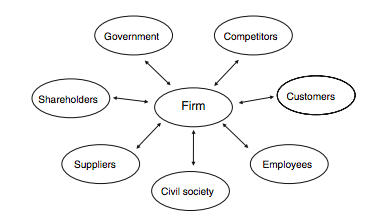Stakeholder analysis
Mariapanousi (Talk | contribs) |
Mariapanousi (Talk | contribs) |
||
| Line 18: | Line 18: | ||
=Stakeholder analysis process= | =Stakeholder analysis process= | ||
| − | |||
| + | There are several approaches regarding the stakeholder analysis process in the bibliography, but most of them have a common philosophy and can be summarised in four principal steps: Identifying, Prioritising, Profiling and Managing Stakeholders. In the initial stage, there is a need of recognising all the people who are affected or influenced by the project and have an interest in a successful or unsuccessful result. Stakeholders can be internal such as managers and employees or external like customers or suppliers. Stakeholders can also be characterized primary with a direct interest and stake to the project (employees, customer, suppliers) or secondary who do not engage in direct exchange but are affected by or can affect the project (business partners, competitors, regulatory authority). The next step is to asses and prioritize stakeholders according to their importance related to the project. Subsequently, stakeholder engagement follows, and the stakeholder analysis process finishes with stakeholder management process. | ||
===Identify stakeholders=== | ===Identify stakeholders=== | ||
Revision as of 20:17, 15 May 2019
Contents |
Abstract
A stakeholder can be shortly described either as an individual, group or organisation who is affected by the output of a project. Stakeholders have an engagement in the achievement of the project and can be inside or outside the organisation that is supporting the project.
Key words: Stakeholders, Stakeholders analysis, Project Management, Portfolio Management, Program Management
Stakeholders and stakeholder analysis
According to the classic definition of stakeholders from Project Management Institute that is relevant for any project case “Stakeholders of a project are individuals, groups, or organizations that are affected or recognized to be affected either in a positive or negative way by a decision, action, or output of a project”.i Stakeholder analysis is referred as the systematic gathering and analysis of quantitative and qualitative data to decide whose interests should be taken into consideration throughout the project. The objective of performing a stakeholder analysis is to provide the project manager and project team an overview of the people who have interest in the project. It should be one of the first steps of each project. It aims to identify everyone with a concern who needs to be involved.
History
The term stakeholder in terms of definition, use and purpose constitutes a quite unclear concept in the literature and it tend to vary over the years. The first time the term ‘stakeholder’ appeared in the bibliography was in 1963 at the Stanford Research Institute (SRI) and originally included owners, employees, customers, supplier, lenders and society. However, it is truth that the business world was thinking and utilizing the stakeholder idea many years before 1960s. According to Dodd (1932), GEC was identifying shareholders, employees, customers, and the general public as the main groups that they had to handle. Sapieca (1990) stated that Johnson & Johnson determined customers, employees, managers, and the general public in 1947. Igor Ansoff and Robert Steward developed further the term based on the SRI’s approach. Freeman (1984) present the definition of stakeholders as “any group or individual who can affect or is affected by the achievement of the organization objectives” in his book “Strategic Management: A Stakeholder Approach. This is one of the most popular definitions as 20 out of 75 in total share this approach. In the figure below, the original stakeholder model from Freeman is presented.

Stakeholder analysis process
There are several approaches regarding the stakeholder analysis process in the bibliography, but most of them have a common philosophy and can be summarised in four principal steps: Identifying, Prioritising, Profiling and Managing Stakeholders. In the initial stage, there is a need of recognising all the people who are affected or influenced by the project and have an interest in a successful or unsuccessful result. Stakeholders can be internal such as managers and employees or external like customers or suppliers. Stakeholders can also be characterized primary with a direct interest and stake to the project (employees, customer, suppliers) or secondary who do not engage in direct exchange but are affected by or can affect the project (business partners, competitors, regulatory authority). The next step is to asses and prioritize stakeholders according to their importance related to the project. Subsequently, stakeholder engagement follows, and the stakeholder analysis process finishes with stakeholder management process.
Identify stakeholders
The first key step in stakeholder analysis process is to identify all the people(individuals or groups) and organisations that are impacted by the project, and report all relevant information concerning their interests, engagement, influence and affect on project success.
Prioritise stakeholders
Profile stakeholders
Stakeholder Management Processes
References
- ↑ Freeman, R.E. (1984) Strategic Management: A Stakeholder Approach.